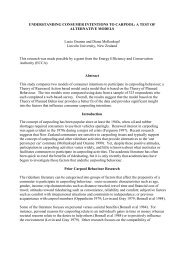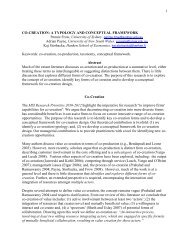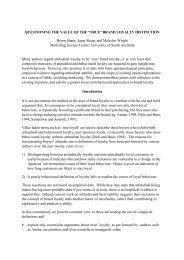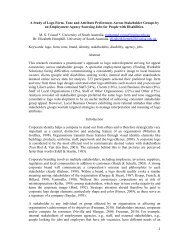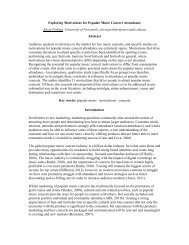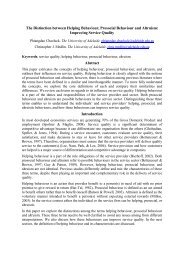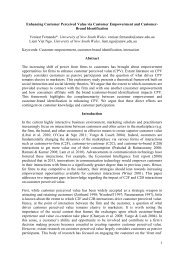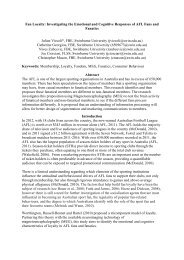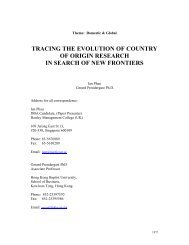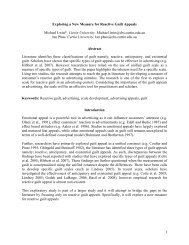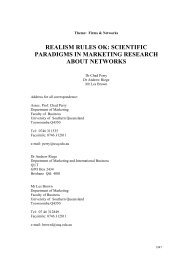A New Set Of Measurements For The Materialism Scale ... - ANZMAC
A New Set Of Measurements For The Materialism Scale ... - ANZMAC
A New Set Of Measurements For The Materialism Scale ... - ANZMAC
Create successful ePaper yourself
Turn your PDF publications into a flip-book with our unique Google optimized e-Paper software.
4. Results<br />
<strong>The</strong> 16 items of <strong>Materialism</strong> <strong>Scale</strong> were subjected to exploratory factor analysis (EFA) using<br />
SPSS version 19. Prior to performing the EFA, the suitability of data for factor analysis was<br />
assessed. In all samples, inspection of the correlation matrix revealed the presence of many<br />
coefficients of .3 and above. <strong>The</strong> Kaiser Meyer-Olkin values for the three student samples were<br />
.775, .817 and .860 while KMO values for the consumer sample from Vietnam was .895, all<br />
exceeding the recommended value of .6 (Kaiser, 1970; 1974) and Bartlett‟s Test of Sphericity<br />
(Bartlett, 1954) reached statistical significance supporting the factorability of the correlation<br />
matrix.<br />
EFA and reliability analysis revealed the presence of four factors with eigenvalues exceeding 1.<br />
An inspection of the scree plot also supported the four-factor solution by showing a clear break<br />
after the fourth component (Catell, 1996). To aid in the interpretation of these four factors,<br />
Varimax rotation was performed. <strong>The</strong> rotated component matrix for the 3 student samples is<br />
shown in Table 1. Based on the result, four factors are namely Material Success, Material<br />
Happiness, Material Essentiality and Material Distinctiveness. Through four different occasions<br />
of the study, the original set of questions for Material Centrality was found to measure various<br />
factors and therefore it has to be replaced by Material Essentiality, which provides a more<br />
concrete appraisal of the belief that possessions are essential and responsible for everything in<br />
one‟s life. This belief is also found to be more in line with the whole idea of materialism and<br />
much clearer than the vague “the extent to which possessions are placed in the center of one‟s<br />
life” of the Material Centrality. And Material Distinctiveness measures the extent to which one<br />
uses possessions as a device to stand out of the crowd.<br />
Table 1: Rotate Component Matrix<br />
Student<br />
Student<br />
Student<br />
Consumer<br />
Items<br />
Sample 1 (n=184) Sample 2 (n=89) Sample 3 (n=419) Sample (n=400)<br />
1 2 3 4 1 2 3 4 1 2 3 4 1 2 3 4<br />
Material Success. a .736 .833 .788<br />
.817<br />
Material Success. b .833 .880 .840 .845<br />
Material Success. c .840 .340 .766 .800 .826<br />
Material Success. d .757 .307 .865 .816 .817<br />
Material Happiness. a .696 .669 .705<br />
.753<br />
Material Happiness. b .711 .796 .740 .730<br />
Material Happiness. c .791 .845 .830 .820<br />
Material Happiness. d .775 .750 .779 .772<br />
Material Essentiality. a .942 .734 .475 .855 .820<br />
Material Essentiality. b .916 .914 .898 .878<br />
Material Essentiality. c .944 .902 .878 .866<br />
Material Essentiality. d .911 .844 .856 .831<br />
Material Distinctiveness. a .838 .874 .847<br />
.858<br />
Material Distinctiveness. b .857 .894 .854 .859<br />
Material Distinctiveness. c .421 .856 .706 .831<br />
Material Distinctiveness. d .742 .671 .720 .753<br />
Over the 3 student samples, coefficient alpha estimates for the factors ranged from .863 to .906<br />
for the success factor, from .813 to .859 for the happiness factor, from .824 to .969 for the<br />
essentiality, and .732 to .900 for the distinctiveness factor. Alpha for the overall 16-item scale




